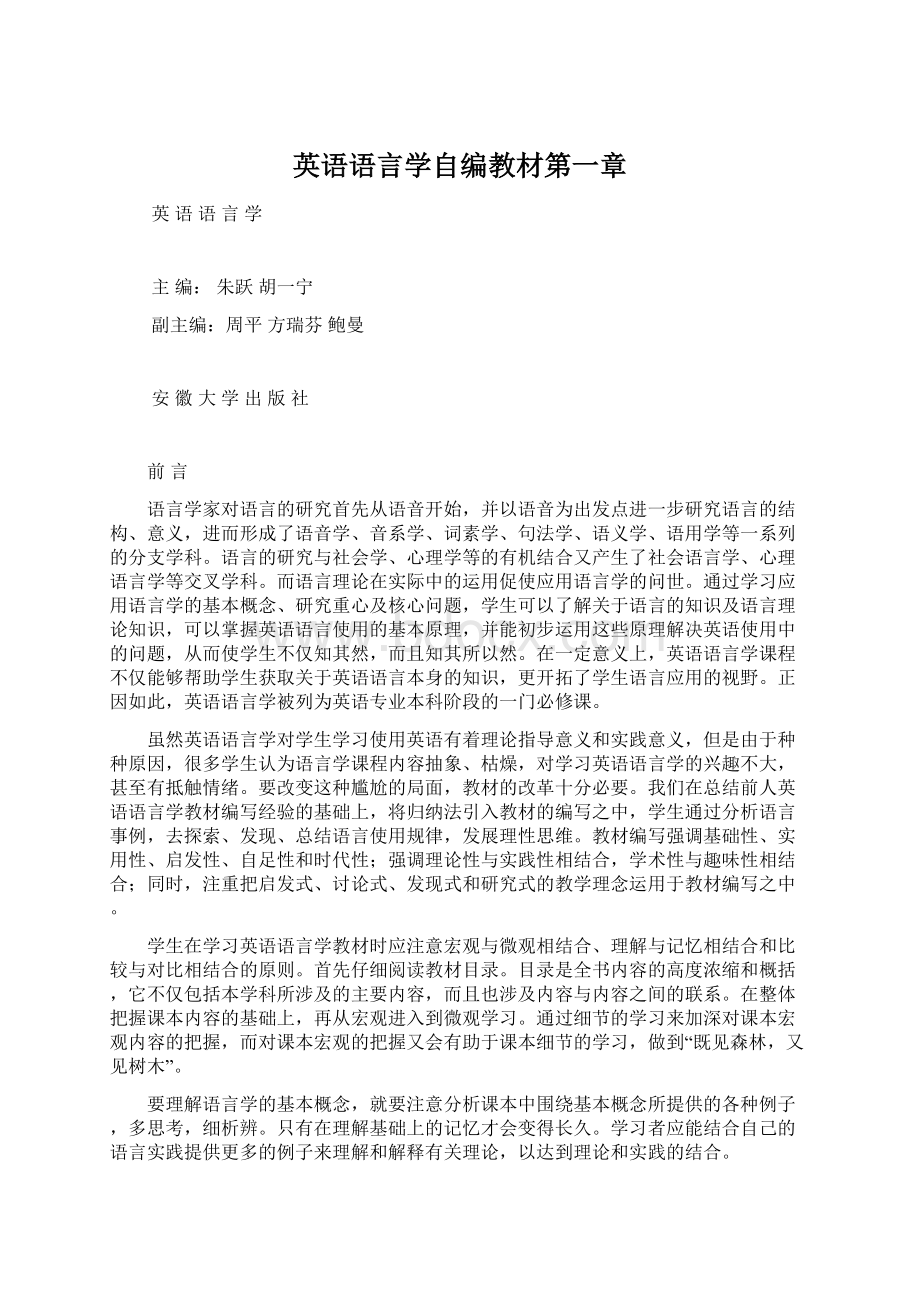英语语言学自编教材第一章.docx
《英语语言学自编教材第一章.docx》由会员分享,可在线阅读,更多相关《英语语言学自编教材第一章.docx(21页珍藏版)》请在冰豆网上搜索。

英语语言学自编教材第一章
英语语言学
主编:
朱跃胡一宁
副主编:
周平方瑞芬鲍曼
安徽大学出版社
前言
语言学家对语言的研究首先从语音开始,并以语音为出发点进一步研究语言的结构、意义,进而形成了语音学、音系学、词素学、句法学、语义学、语用学等一系列的分支学科。
语言的研究与社会学、心理学等的有机结合又产生了社会语言学、心理语言学等交叉学科。
而语言理论在实际中的运用促使应用语言学的问世。
通过学习应用语言学的基本概念、研究重心及核心问题,学生可以了解关于语言的知识及语言理论知识,可以掌握英语语言使用的基本原理,并能初步运用这些原理解决英语使用中的问题,从而使学生不仅知其然,而且知其所以然。
在一定意义上,英语语言学课程不仅能够帮助学生获取关于英语语言本身的知识,更开拓了学生语言应用的视野。
正因如此,英语语言学被列为英语专业本科阶段的一门必修课。
虽然英语语言学对学生学习使用英语有着理论指导意义和实践意义,但是由于种种原因,很多学生认为语言学课程内容抽象、枯燥,对学习英语语言学的兴趣不大,甚至有抵触情绪。
要改变这种尴尬的局面,教材的改革十分必要。
我们在总结前人英语语言学教材编写经验的基础上,将归纳法引入教材的编写之中,学生通过分析语言事例,去探索、发现、总结语言使用规律,发展理性思维。
教材编写强调基础性、实用性、启发性、自足性和时代性;强调理论性与实践性相结合,学术性与趣味性相结合;同时,注重把启发式、讨论式、发现式和研究式的教学理念运用于教材编写之中。
学生在学习英语语言学教材时应注意宏观与微观相结合、理解与记忆相结合和比较与对比相结合的原则。
首先仔细阅读教材目录。
目录是全书内容的高度浓缩和概括,它不仅包括本学科所涉及的主要内容,而且也涉及内容与内容之间的联系。
在整体把握课本内容的基础上,再从宏观进入到微观学习。
通过细节的学习来加深对课本宏观内容的把握,而对课本宏观的把握又会有助于课本细节的学习,做到“既见森林,又见树木”。
要理解语言学的基本概念,就要注意分析课本中围绕基本概念所提供的各种例子,多思考,细析辨。
只有在理解基础上的记忆才会变得长久。
学习者应能结合自己的语言实践提供更多的例子来理解和解释有关理论,以达到理论和实践的结合。
比较和对比是该课程学习中不可缺少的两种方法。
通过比较,可以找出不同概念之间的相似性,通过对比可以理解不同概念之间的相异性。
比较和对比的结合有助于弄清概念之间的异同及其内在的联系。
《新概念英语语言学教程》是集体的智慧。
除了主编与副主编外,参加教材编写工作和校对工作的还有段婷婷、李剑、李义成、李奕华、王军、张佳易、周同、朱军等(以姓氏笔画排序)。
在此,我们向他们表示感谢。
由于我们水平有限,教材中错误难免,恳请广大教师与读者多提宝贵意见和建议,以便我们对教材作进一步修订。
朱跃
2010年1月于安徽大学
Chapter1Introduction
1.Whatislinguistics?
.......................................................................
1.1Definitionoflinguistics…………………………………………..
1.2Mainbranchesoflinguistics…………………………………….
1.3Whystudylanguage?
…………………………………………..
2.Whatislanguage?
……………………………………………………….
2.1Definitionoflanguage………………………………………………..
2.2Designfeaturesoflanguage……………………………..
3.Importantdistinctionsinlinguistics………………………………………
3.1Prescriptivevs.descriptive…………………………………………………
3.2Synchronicvs.diachronic…………………………………………………..
3.3Speechvs.writing…………………………
3.4Languevs.parole……………………………..
3.5Competencevs.performance………………………………………….
Exercises………………………………………………………………….
FurtherReading……………………………………………………………………..
Chapter2Phonetics
1.Thephonicmediumoflanguage…………………….
2.Phonetics……………………………………………
2.1Whatisphonetics?
…………………………………..
2.2Organsofspeech………………………………..
2.2.1Theoralcavity……………………………
2.2.2Thenasalcavity ……. …………………….
2.2.3Pharyngealcavity………………………………
2.3ClassificationofEnglishspeechsounds…………..
2.3.1ClassificationofEnglishconsonants…………………………..
2.3.2ClassificationofEnglishvowels………………………..
Exercises……………………………………..
FurtherReading………………………………………………..
Chapter3Phonology
1.Generalintroductiontophonology…………………………………
2.Basicconceptsofphonology……………………………
2.1Phone,phonemeandallophone………………….
2.2Phonemiccontrast,complementarydistributionandminimalpair….
2.3Broadtranscriptionandnarrowtranscription…………………
3.Somephonologicalrules………………………………………………
3.1Sequentialrules………………………………………………………..
3.2Assimilationrules……………………………………………………
4.Suprasegmentalfeatures:
stress,toneandintonation……………………….
4.1Stress……………………………………………………………….
4.2Tone…………………………………………………….
4.3Intonation………………………………………………………………….
Exercises…………………………………………………………………………….
FurtherReading……………………………………………………………………..
Chapter4Morphology………………………………………………………………
1.Morphology………………………………………..
2.Morphemes……………………………………………..
3.Typesofmorphemes……………………………………………………
3.1Freemorphemes………………………………………………………………
3.2Boundmorphemes…………………………………………………………….
3.2.1Root…………………………………………………………………….
3.2.2Affixes………………………………………………………………….
4.Allomorph…………………………………………………………….
5.Wordformationrules………………………………………………………..
5.1Compounding………………………………………………………………..
5.2Derivation…………………………………………………………………..
5.3Conversion………………………………………………………………….
5.4Clipping………………………………………………………………………
5.5Initialism……………………………………………………………..
5.6Acronym……………………………………………………….
5.7Blending………………………………………………………..
5.8Back-formation………………………………………………………
Exercises……………………………………………………………………..
FurtherReading………………………………………………………………………………….
Chapter5Syntax……………………………………………………………
1.Syntacticcategories……………………………………………..
2.Combinationalrules………………………………………………
3.Sentencestructure………………………………………………………..
3.1ThestructuralapproachandICanalysis…………………………………
3.2AdvantagesandproblemsofICanalysis
3.3Transformational-generativegrammar………………………………………..
3.3.1Surfacestructureanddeepstructure…………………………………
3.3.2Phrasestructurerules……………………………………
3.3.3Transformationalrules…………………………………
3.3.4Morphophonemicrules…………………………………
4.Universalgrammar…………………………………
4.1TheobservationalbasisofUG………………………………………….
4.2GeneralprinciplesofUG…………………………………………..
4.2.1Thestructure-dependencyprinciple……………………….
4.2.2Thesubjacencyprinciple………………………………….
4.2.3Theadjacencyprinciple…………………………………
4.3GeneralparametersofUG……………………………………….
4.3.1Thepro-dropparameter………………………………….
4.3.2Theadjacencyparameter……………………………………
4.3.3Thedirectionalityparameter…………………………………………
Exercises……………………………………………………
FurtherReading……………………………………………………………..
Chapter6Semantics
1.Generalintroduction……………………………..
2.Approachestosemantics……………………………………………………..
2.1Thenamingtheory………………………………………………………
2.2Theconceptualisttheory………………………………………………
2.3Contextualism…………………………………………………..
2.4Behaviorism…………………………………………………………..
3.Lexicalmeaning………………………………………………………….
3.1Senseandreference……………………………………………………
3.2.Majorsemanticrelationshipsbetweenwords………………………..
3.2.1Synonymy…………………………………………………………….
3.2.2Polysemy……………………………………………………………..
3.2.3Homonymy……………………………………………………………
3.2.4Hyponymy……………………………………………………………….
3.2.5Antonymy……………………………………………………………..
4.Sentencemeaning………………………………………………………………
5.Analysisofmeaning……………………………………………………………..
5.1Componentialanalysis—awaytoanalyzelexicalmeaning………….
5.2Predicationanalysis—awaytoanalyzesentencemeaning…………..
Exercises…………………………………………………………………
FurtherReading………………………………………………………………………..
Chapter7Pragmatics…………………………………………………………
1.Whatispragmatics?
……………………………………………………….
2.Context…………………………………………………………..
3.Entailment……………………………………………….
4.Presupposition…………………………………………………..
5.Speechacts…………………………………………………………………….
6.Conversationalimplicatures……………………………………………….
7.Thecooperativeprinciple……………………………………………………..
8.Deixis…………………………………………………………………………..
9.Politenessprinciple………………………………………………………………….
Exercises…………………………………………………………………….
FurtherReading……………………………………………………………………….
Chapter8LanguageandSociety
1.Speechcommunity………………………………………………….
2.Relationshipsbetweenlanguageandsociety………………………………
3.Languagevarieties……………………………………………………………..
3.1Dialects………………………………………………………………………
3.1.1Regionaldialects…………………………………………………….
3.1.2Socialdialects……………………………………………………………..
3.1.2.1Languagevariationwithsocialclasses:
classdialect………
3.1.2.2Languagevariationwithsex:
genderlect……………………
3.1.2.3Languagevariationwithage:
Agedialect………………….
3.1.2.4Languagevariationwithethnicgroup:
ethnicdialect……….
3.1.2.5Languagevariationwithindividuals:
idiolect……………
3.1.3Standarddialect……………………………………………………
3.2Register……………………………………………………………….
3.3Mixtureofvarieties…………………………………………………………
3.3.1Pidgins………………………………………………………………….
3.3.2Creoles………………………………………………………………
3.3.3Linguafranca…………………………………………………………….
Exercises………………………………………………………………………….
FurtherReadings…………………………………………………………………
Chapter9LanguageandCulture
1.Generalintroduction………………………………………………………
1.1Therelationshipbetweenlanguageandculture……………………..
1.2TheSapir-Whorfhypothesis………………………………..
2.Cross-culturalcommunication…………………………..
2.1Meaningassign………………………………………………..
2.2Culturalclash………………………………………………………
2.3Stereotype…………………………………………………………
Exercises………………………………………………………………..
FurtherReading……………………………………………………………..
Chapter10LanguageandAcquisition
1.Behaviorism…………………………………………………………………………
2.Innatism:
howlanguagesarelearned…………………………………..
3.Interactionisttheory:
howlanguagesarelearned……………………….
4.Interlanguage:
howlanguagesarelearned………………………………..
5.Acquisitionvs.learning……………………………………………….
6.Competenceandperformance………………………………………………
7.Universalgrammar………………………………………………………….
8.Languagetransfer………………………………………………………………..
9.Comprehensibleinput………………………………………………………………
10.Criticalperiodhypothesis………………………………………………
Exercises…………………………………………………………..
FurtherReading……………………………………………………….
Chapter11LanguageandMethodology
1.Approachestolanguageteaching…………………………………………………
2.Contributionoflinguisticstolanguageteaching…………………………………..
3.Languagetesting……………………………………………..
3.1Basicconsiderationsoflanguagetesting…………………………
3.2Maintypesoflanguagetests……………………………………………
Exercises……………………………………………………………………..
FurtherReading…………………………………………………………….
References
Chapter1Introduction
1.WhatisLinguistics?
1.1DefinitionofLinguistics
●RelevantLanguageUseObservationsandQuestionstoPonderover
1)
Whatdoyouthinklinguisticsisabout?
2)Discusswithyourpartnerhowwecanstudylanguageinascientificway?
3)Inyouropinion,what’sthegoalofalinguist?
●SummariestoMakeandLinguisticViewpointstoLearn
Linguisticsisthescientificstudyoflanguage.Theword“language”withnoarticleimpliesthatlinguisticsstudieslanguagesingeneral,notanyparticularlanguage.Theword“study”means“investigate”or“examine”insteadof“learn”.Linguisticsendeavorstoanswerthequestionsofwhatlanguageisandhowitisrepresentedinthemind?
Ascientificstudyoflanguageisbasedonthesystematicinvestigationofdata,conductedwithreferencetosomegeneraltheoryoflanguagestructure.Linguistsfocusondescribingandexplaininglanguageandarenotconcernedwiththeprescriptiverulesofthelanguage.Linguistsare